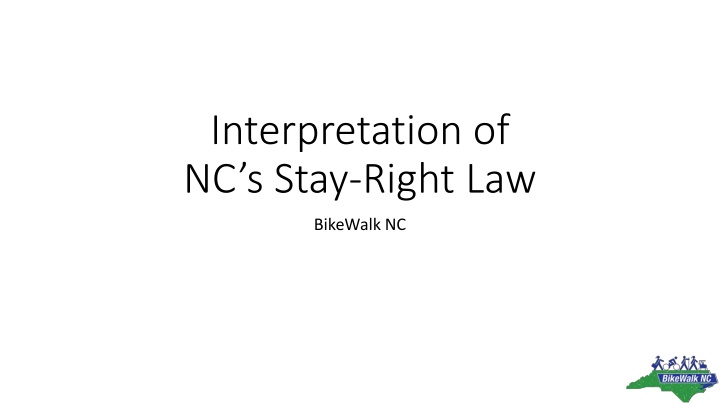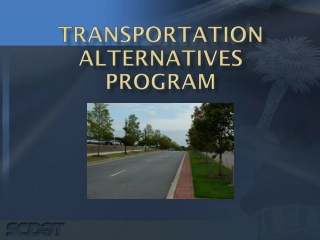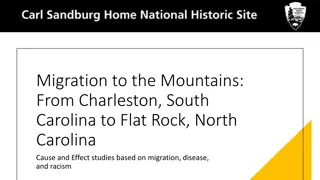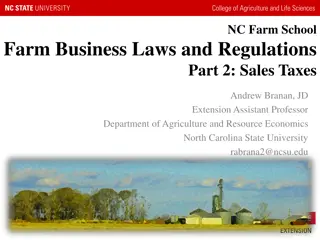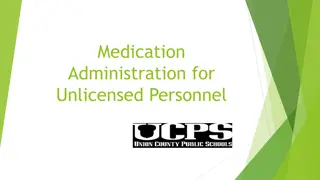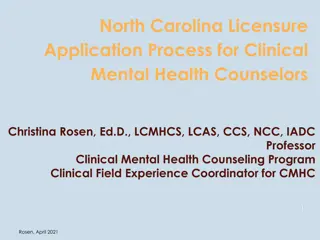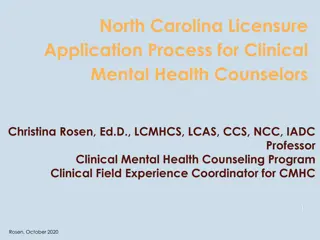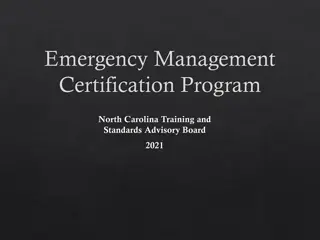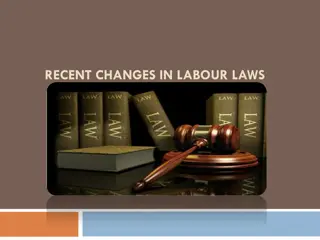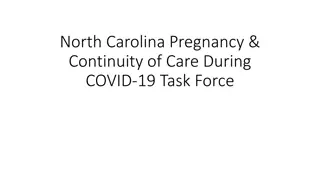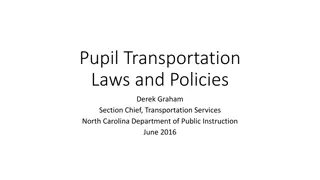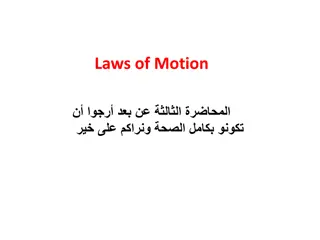Evolution of Stay-Right Laws in North Carolina
Stay-Right laws in North Carolina have a rich historical background, evolving from the 1926 Uniform Vehicle Code to the current regulations that require vehicles to stay in the right-hand lane for through traffic or as close as practicable to the right-hand edge of the highway. Over the years, there have been amendments and exceptions made to accommodate various road users, including bicycles, ensuring safe and efficient traffic flow.
Uploaded on Sep 17, 2024 | 1 Views
Download Presentation

Please find below an Image/Link to download the presentation.
The content on the website is provided AS IS for your information and personal use only. It may not be sold, licensed, or shared on other websites without obtaining consent from the author.If you encounter any issues during the download, it is possible that the publisher has removed the file from their server.
You are allowed to download the files provided on this website for personal or commercial use, subject to the condition that they are used lawfully. All files are the property of their respective owners.
The content on the website is provided AS IS for your information and personal use only. It may not be sold, licensed, or shared on other websites without obtaining consent from the author.
E N D
Presentation Transcript
Interpretation of NC s Stay-Right Law BikeWalk NC
NC NC 20 20- -146 146 (b) Upon all highways any vehicle proceeding at less than the legal maximum speed limit shall be driven in the right-hand lane then available for thru traffic, or as close as practicable to the right-hand curb or edge of the highway, except when overtaking and passing another vehicle proceeding in the same direction or when preparing for a left turn.
Historical Summary of Stay-Right Laws 1926 UVC: Combination right-half and slow-vehicle rule 1930 UVC: Separate rules for roads with and without lane markings 1948 UVC: Combined slow-vehicle rules, separated right-half rule 1944 UVC: First bicycle-specific stay-right rule appears 1963: CHP lobbies California to adopt bicycle-specific stay-right rule 1975: NCUTLO Panel on Bicycle Laws recommends complete repeal of bicycle-specific rule 1976, 1979: Exception added for a lane that is too narrow for a bicycle and a vehicle to travel safely side by side within the lane 2013: BMUFL signs included in MUTCD
1926 UVC: Drive on Right Side of Highway Section 10. Drive on Right Side of Highway. Upon all highways of sufficient width, except upon one way streets, the driver of a vehicle shall drive the same upon the right half of the highway and shall drive a slow moving vehicle as closely as possible to the right-hand edge or curb of such highway, unless it is impracticable to travel on such side of the highway and except when overtaking and passing another vehicle subject to the limitations applicable in overtaking and passing set forth in Sections 13 and 14 of this act.
1937 NC Stay-Right Law (Exact Copy of 1926 UVC) Sec 108. Drive on Right Side of Highway. Upon all highways of sufficient width, except upon one-way streets, the driver of a vehicle shall drive the same upon the right half of the highway, and shall drive a slow-moving vehicle as closely as possible to the right-hand edge or curb of such high-way, unless it is impracticable to travel on such side of the high-way and except when overtaking and passing another vehicle subject to the limitations applicable in overtaking and passing, set forth in sections one hundred and eleven and one hundred and twelve of this Act.
1930 UVC: Added a Section for Marked Lanes Separate slower-vehicle rules for laned and unlaned roadways!
1930 UVC: Drive on Right Side of Highway Section 26. Drive on Right Side of Highway (a) Upon all highways of sufficient width, other than one-way highways [except upon one way streets], the driver of a vehicle shall drive the same upon the right half of the highway [and shall drive a slow moving vehicle as closely as possible to the right-hand edge or curb of such highway,] except when the right half is out of repair and for such reason impassable [unless it is impracticable to travel on such side of the highway] or when overtaking and passing another vehicle subject to the limitations [applicable in overtaking and passing] set forth in Section 30 [Sections 13 and 14]. (b) In driving upon the right half of the highway the driver shall drive as closely as practicable to the right hand edge or curb of the highway except when overtaking or passing another vehicle, or when placing a vehicle in position to make a left turn.
1930 UVC: Streets and Highways Laned for Traffic Section 27. Special Regulations Applicable on Streets and Highways Laned for Traffic. Whenever any street or highway has been divided into clearly marked lanes for traffic drivers of vehicles shall obey the following regulations: (a) A vehicle shall normally be driven in the lane nearest the right hand edge or curb of the highway when said lane is available for travel except when overtaking another vehicle or in preparation for a left turn .
Marked Lane Use 11-309 Driving on Roadways Laned for Traffic Whenever any roadway has been divided into two or more clearly marked lanes for traffic the following rules in addition to all others consistent herewith shall apply. A vehicle shall be driven as nearly as practicable entirely within a single lane and shall not be moved from such lane until the driver has first ascertained that such movement can be made with safety.
1948 UVC Cleaned Up Stay-Right Rules Separated the right-half-of-the-roadway rule from slower vehicle rules Combined the slower vehicle rules for laned and unlaned roadways into one subsection
1948 UVC : Slower Vehicles Rule 11-301 Drive on Right Side of Roadway Exceptions (b) Upon all roadways any vehicle proceeding at less than the normal speed of traffic at the time and place and the conditions then existing shall be driven in the right lane then available for traffic, oras close as practicable to the right hand curb or edge of the roadway, except overtaking and passing another vehicle proceeding in the same direction or when preparing for a left turn at an intersection or into a private road or driveway.
1965 NC Slower Vehicles Rule 20-146. Drive on Right Side of Roadway; Exceptions (b) Upon all roadways any vehicle proceeding at less than the normal speed of traffic at the time and place and under the conditions then existing shall be driven in the right-hand lane then available for thru traffic, or as close as practicable to the right-hand curb or edge of the roadway, except when overtaking and passing another vehicle proceeding in the same direction or when preparing for a left turn.
1979 UVC : Slower Vehicles Rule 11-301 Drive on Right Side of Roadway Exceptions (b) Upon all roadways any vehicle proceeding at less than the normal speed of traffic at the time and place and the conditions then existing shall be driven in the right lane then available for traffic, oras close as practicable to the right hand curb or edge of the roadway, except overtaking and passing another vehicle proceeding in the same direction or when preparing for a left turn at an intersection or into a private road, alley or driveway. The intent of this subsection is to facilitate the overtaking of slowly moving vehicles by faster moving vehicles.
TODAY NC Slower Vehicles Law 20-146. Drive on Right Side of Roadway; Exceptions (b) Upon all highways any vehicle proceeding at less than the legal maximum speed limit shall be driven in the right-hand lane then available for thru traffic, or as close as practicable to the right-hand curb or edge of the highway, except when overtaking and passing another vehicle proceeding in the same direction or when preparing for a left turn.
Our Interpretation of 20-146/UVC 11-301(b) If lanes are marked, slower drivers shall use the right hand lane. If no lanes are marked, slower drivers shall drive as far right as practicable (safe and practical). This interpretation is common among bicycle law experts across the US NCUTLO Panel on Bicycle Laws made same interpretation in 1975
Shea Denning Professor at University of North Carolina School of Law G.S. 20-146(b) requires any vehicle proceeding at less than the speed limit to be driven in the right-hand lane available for thru traffic, or as close as practicable to the right-hand curb or edge of the highway, except when overtaking and passing another vehicle proceeding in the same direction or when preparing for a left turn. The or seems to render the second clause inapplicable to cyclists riding in the right lane of a road divided into lanes, regardless of whether they are passing another vehicle or preparing for a left turn. https://nccriminallaw.sog.unc.edu/figuring-out-how-to-best-share-the-road/ Shea Denning joined the School of Government in 2003. Shea specializes in motor vehicle law and the criminal laws and procedures associated with this subject area, including the law of search and seizure and the rules of evidence. https://www.sog.unc.edu/about/faculty-and-staff/shea-riggsbee-denning
Other US States without Bicycle-Specific Stay- Right Laws Arkansas, Massachusetts, Pennsylvania, Indiana, and Iowa also have only generic stay-right laws (no bicycle-specific stay-right laws). AK, MA, PA, IN, and IA have deployed BMUFL signs. They interpret their generic stay-right laws as allowing bicyclists to use the lane normally and do not require bicyclists to stay right within the lane
Arkansas When You Should Take a Lane If there is no shoulder or bike lane, and the travel lane is narrow, ride closer to the center of the lane. This will prevent motorists from passing you when there isn t room. https://www.arkansashighways.com/publications/Bike%20safety- doc12a.pdf
Massachusetts https://www.mass.gov/files/documents/2017/09/29/Drivers_Manual.pdf
Pennsylvania RIDING ON THE ROADWAY Bikes may be ridden on the shoulder of the road (in the same direction as the flow of traffic) but are not required to do so. Bikes may also ride on the right half of the roadway as follows: On a multilane roadway, bikes may be ridden in the right-most travel lane. On a two-lane roadway, a bike may be ridden in the right lane. On a roadway with no center line, a bike may be ridden anywhere on the right side of the roadway. http://www.penndot.gov/TravelInPA/RideaBike/Pages/Bicycle-Safety- and-Pennsylvania-Laws.aspx
Iowa a bicyclist is allowed to use the travel lane of a roadway and may use the full lane if they feel that the right edge of the road way is unsafe in any way . http://www.cedar-rapids.org/local_government/departments_g_- _v/police/bicycle_laws.php Give bicycle riders the room they deserve and need for safety. When passing a bicycle rider, pass as if the cyclist were a vehicle and move into the other lane. On narrow, two-way roads, wait for a break in traffic before passing. Do not pass if oncoming traffic is near. After passing, cautiously return to your lane - a bicyclist could be in your blind spot. Do not honk your horn or flash your headlights at bicyclists. They may be startled and lose control. Bicycles often travel nearer the right edge of a traffic lane. However, they may swerve to avoid road hazards such as potholes, glass debris, drainage grates, or a strong crosswind. https://www.iowadot.gov/mvd/ods/dlmanual/dlmanual.pdf
Indiana "According to the letter of the law, a cyclist can be in the middle of the road in his lane cycling, as long as he's following the rules of the road," says Lance Worland, a personal injury lawyer with Caress Law Group. "I think drivers a lot of times aren't aware of that, and don't realize the cyclist has a right to be there. https://www.indystar.com/story/news/2014/07/10/collision-course- confusing-laws-vex-indiana-drivers-cyclists/12489675/
Part 2: Bicycle-Specific Law UVC and Other States
1926 UVC : Bicycles Are Vehicles Vehicle. Every device in, upon or by which any person or property is or may be transported or drawn upon a public highway, excepting devices moved by human power or used exclusively upon stationary rails or tracks; provided, that for the purposes of (Title II of) this act, a bicycle or a ridden animal shall be deemed a vehicle.
New York 1262 VAT Title 7 Article 34 1234. Riding on roadways, shoulders, bicycle or in-line skate lanes and bicycle or in-line skate paths. (a) Upon all roadways, any bicycle or in- line skate shall be driven either on a usable bicycle or in-line skate lane or, if a usable bicycle or in-line skate lane has not been provided, near the right-hand curb or edge of the roadway or upon a usable right-hand shoulder in such a manner as to prevent undue interference with the flow of traffic except when preparing for a left turn or when reasonably necessary to avoid conditions that would make it unsafe to continue along near the right-hand curb or edge.
1944 UVC First Bicycle-Specific Stay-Right Rule UVC 11-1205 Riding on roadways and bicycle paths (a) Any person operating a bicycle upon a roadway shall ride as near to the right-hand side of the roadway as practicable, exercising due care when passing a standing vehicle or one proceeding in the same direction. No evidence that bicycling orgs were ever consulted about rule California Highway Patrol lobbied legislature in 1963 to adopt the bicycles- stay-right law adopted Law never adopted into law by North Carolina, Massachusetts, Pennsylvania, Indiana, Iowa or Arkansas
1975: NCUTLO Bicycle Panel Recommends Repeal NCUTLO Report of the Panel on Bicycle Laws Panel Recommendation: Delete UVC 11-1205(a) and allow bicyclists to use the roadway under the same conditions as other drivers The side of the road is a very dangerous place to ride UVC 11-301(b) will effectively require bicycles to stay in the right lane (although it will not require them to stay near the right edge of the roadway) when moving slower than other traffic. This is all that is needed.
UVC 1979-2000: Exceptions Added to Bike Rule 11-1205 Position on roadway [2000 version listed here] (a) Any person operating a bicycle or a moped upon a roadway at less than the normal speed of traffic at the time and place and under the conditions then existing shall ride as close as practicable to the right-hand curb or edge of the roadway except under any of the following situations: 1. When overtaking and passing another bicycle or vehicle proceeding in the same direction. 2. When preparing for a left turn at an intersection or into a private road or driveway. 3. When reasonably necessary to avoid conditions including, but not limited to, fixed or moving objects, parked or moving vehicles, bicycles, pedestrians, animals, surface hazards, or substandard width lanes that make it unsafe to continue along the right-hand curb or edge. For purposes of this section, a substandard width lane is a lane that is too narrow for a bicycle and a vehicle to travel safely side by side within the lane. .
1976 Present: Promoting Lane Control All adult bicycling education programs in North America and Britain (LAB Traffic Skills 101, CyclingSavvy, IPMBA, CAN-BIKE, and British Cycling Bikeability) teach lane control to deter passing in narrow lanes NCUTCD adds R4-11 Bicycles May Use Full Lane sign to 2009 MUTCD
2013 ITE Traffic Control Devices Handbook Chapter 14, "Narrow Lanes "In locations where the outside travel lane is less then 14 ft. (4.3 m), there is insufficient lateral room for a bicyclist and a motor vehicle to travel side by side in the same lane with adequate separation distance between two vehicles. In this situation, the "as far right as practicable" requirement, found in section 11-1205(a) of the UVC and the traffic laws of most states, is waived, and bicyclists are legally permitted to position themselves laterally on the roadway in a manner that discourages too-close passing or being squeezed to the curb or roadway edge by passing traffic. However, many bicyclists and other road users may not be aware of this law, and may incorrectly assume they must always stay to the far right of the roadway.
2013 ITE Traffic Control Devices Handbook In locations with narrow travel lanes where operational problems (such as high incidences of sidewalk riding) have been observed, the use of shared lane markings or BICYCLES MAY USE FULL LANE (R4-11) signs may be beneficial in encouraging appropriate and legal use of the lane by bicyclists."
2013 ITE Traffic Control Devices Handbook "Shared Lane Markings...Mid-Block Without Parking "The bicyclist s lateral position should clearly indicate to following motorists whether passing is encouraged. To support this, some agencies increase the minimum right-side offset of the Shared Lane Marking when used in narrow lanes; for example, Florida DOT uses 5.5. ft. (1.7 m) for lanes narrower than 13 ft (4.0 m). Another approach is to center the marking in a lane that is too narrow to share. This clearly indicates a bicyclist is allowed full use of a narrow lane, and is likely to produce more consistent overtaking behavior, encouraging full lane changes into the adjacent travel lane on a multi-lane street, or crossing the centerline when an adequate gap is obtained on a street with only one lane in the bicyclist s direction.
2013 ITE Traffic Control Devices Handbook "...many highways with higher speed limits are open to bicyclists, and many of these do not have shoulders suitable for bicycle travel. As such, some bicyclists will use the full width of a narrow lane to deter unsafe passing, especially if confident of their conspicuity to motorists approaching from behind."
